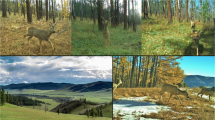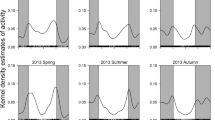Summary
During 1976 to 1978 in the Bavarian Alps (Southern West Germany) the activity patterns of nine female red deer have been studied using radio-telemetry. The daily sum total of activity shows a marked annual cycle, ranging from about 7 h in winter to some 15 h in summer. It becomes obvious that the duration of activity during solar day, night and twilight is not only due to the length of these three periods but also varies independently in the course of the year. The daily pattern of activity reveals a bimodal 24-h rhythm throughout the year. Its two peaks coincide with dawn and dusk. Their temporal position shifts according to the seasonally changing LD-ratio. Also the relative height of the two peaks varies in the course of the year; they decrease in the summer months in favour of more activity during the light time. These daily and annual rhythms rely on corresponding changes in the pattern of activity bursts. In some cases the sequences of activity bursts reflect also influences of weather conditions or of differently structured habitats on the animals' behaviour. The possible influences of some endogenous and exogenous factors on the activity patterns are discussed.
Similar content being viewed by others
References
Andersen J (1961) Biology and Management of roe-deer in Denmark. La Terre et la Vie 1:41–53
Altmann M (1952) Social behavior of elk (Cervus canadensis nelsoni) in the Jackson Hole Area of Wyoming. Behavior 4:116–143
Arman P, Kay RNB, Goodall ED, Sharman GAM (1974) The composition and yield of milk from captive red deer (Cervus elaphus L.). J Reprod Fert 37:67–84
Arnold GW (1969) Regulation of food intake in grazing ruminants. In: AT Phillipson, Physiology of digestion and metabolism in the ruminant. Proc. 3rd Int. Symp. Anim. Prod., pp 264–276
Aschoff J (1962) Spontane lokomotorische Aktivität. Handbuch der Zoologie 8:11, 1–76
Aschoff J (1963a) Circadian activity patterns with two peaks. Ecology 47:657–662
Aschoff J (1963b) Comparative physiology: diurnal rhythms. Ann Rev 25:581–600
Berg FC von (1978) Zum Raum-Zeit-System des Rehes. AFZ 21:48–49
Briedermann L (1971) Ermittlungen zur Aktivitätsperiodik des mitteleuropäischen Wildschweins (Sus scrofa L.). Zool Garten NF, Leipzig 40:302–327
Bubenik AB, Bubenikova LM (1965) 24-h periodicity in red deer. VII Int Congr of Game Biologists, Beograd-Ljubljana, 343–349
Bützler W (1974) Kampf- und Paarungsverhalten, soziale Rangordnung und Aktivitätsperiodik beim Rothirsch. Fortschritte der Verhaltensforschung 16:pp 80
Campling RC (1969) Physical regulation of voluntary intake. In: AT Phillipson, Physiology of digestion and metabolism in the ruminant. Proc 3rd Int Symp Anim Prod, pp 227–233
Carbough B, Vaughan LP, Bellis ED, Graves HB (1975) Distribution and activity of white-tailed deer along an interstate highway. J Wildl Manage 39:570–581
Carpenter LH (1976) Forage intake-24-h activity patterns. Colorado Game Res Rev, pp 4–5
Collins WB, Urness PJ, Austin DD (1978) Elk diets and activities on different lodgepole pine segments. J Wildl Manage 42:799–810
Craighead JJ, Craighead FC, Ruff RL, O'Gara BW (1973) Home ranges and activity patterns of non-migratory elk of the Madison Drainage Herd as determined by biotelemetry. Wildl Monogr 33:pp 50
Ellenberg H (1978) Zur Populationsökologie des Rehes (Capreolus capreolus L.) in Mitteleuropa. Spixiana 2: pp 211
Erkinaro E (1972a) Seasonal changes in the phase position of circadian activity in some voles, and their endogenous component. Aquilo Ser Zool 13:87–91
Erkinaro E (1972b) Fasväxling hos djur. Fauna och Flora 67:215–219
Geist V (1963) On the behavior of the north american moose (Alces alces andersoni Peterson 1950) in British Columbia. Behavior 20:377–416
Georgii B (1978) Monitoring activity of free-ranging wild ungulates. Biotelemetry IV:179–182
Georgii B (1980) Home range patterns of female red deer (Cervus elaphus L.) in the Alps. Oecologia (Berl) 47:278–285
Georgii B, Schröder W (1978) Radiotelemetrisch gemessene Aktivität weiblichen Rotwildes (Cervus elaphus L.). Z Jagdwiss 24:9–23
Goss RJ (1969) Photoperiodic control of antler cycles in deer. J Exp Zool 170:311–324 and 233–234
Goss RJ, Dinsmore CE, Grimes LN, Rosen JK (1974) Expression and suppression of the circannual antler growth cycle in deer. In: Circannual Clocks, ET Pengelley (ed), Academic Press New York San Francisco London, pp 393–422
Gundlach H (1968) Brutfürsorge, Brutpflege, Verhaltensontogenie und Tagesperiodik beim europäischen Wildschwein. Z Tierpsych 25:955–995
Gwinner E (1972) Endogenous timing factors in bird migration. In: Animal Orientation and Navigation. SR Galler, K Schmidt-Koenig, GL Jacobs, RE Belleville (eds), NASA, Washington, D.C.
Hofmann A, Nievergelt B (1972) Das jahreszeitliche Verteilungsmuster und der Äsungsdruck von Alpensteinbock, Gemse, Rothirsch und Reh in einem begrenzten Gebiet im Oberengadin. Z Jagdwiss 18:185–218
Jackson J (1977) When do fallow deer feed? Deer 4:215–218
Jaczewski Z (1954) The effect of changes in length of daylight on the growth of antlers in the deer (Cervus elaphus L.) Folia Biologica 2:133–143
Kammermeyer KE, Marchinton RL (1977) Seasonal changes in circadian activity of radio-monitored deer. J Wildl Menage 41:315–317
Klein H (1974) The adaptational value of internal annual clocks in birds. In: Cicannual Clocks. E Pengelley (ed), Academic Press, New York San Francisco London, pp 347–392
Mitchell B, McCowan D, Nicholson IA (1976) Annual cycles of body weight and condition in Scottish red deer (Cervus elaphus L.). J Zool Lond 180:107–127
Mitchell B, Staines BW, Welch D (1977) Ecology of red deer. Institute of Terrestrial Ecology, Banchory, pp 74
Moen AN (1973) Wildlife Ecology. WH Freeman and Co, San Francisco, pp 457
Moen AN (1978) Seasonal changes in heart rates, activity, metabolism, and forage intake of white-tailed deer. J Wildlife Manage. 42:715–738
Moen AN, Chevalier S (1977) Analysis of telemetred ecg signals from white-tailed deer. Proc 1st Int Conf Wildl Biotelemetry, Univ of Wyoming Laramie: 118–125
Montgomery GG (1963) Nocturnal movements and activity rhythms of white-tailed deer. J Wildl Manage 27:422–427
Nordan HC, Cowan IMcT, Wood AJ (1968) Nutritional requirements and growth of black-tailed deer (Odocoileus hemionus columbianus) in captivity. In: Comparative nutrition of wild animals, MA Crawford. Symp Zool Soc Lond 21:153–161
Ozoga JJ, Verme LJ (1970) Winter feeding patterns of penned white-tailed deer. J Wildl Manage 34:431–439
Ozoga JJ, Verme LJ (1975) Activity patterns of white-tailed deer during estrus. J Wildl Manage 39:679–683
Pengelley ET, Asmundson SJ (1971) Annual biological clocks. Scient Amer 224:72–79
Schröder W (1978) Der Rothirsch. Jahrbuch des Vereins zum Schutze der Bergwelt 43:123–150
Schürholz G, Gossow H (1973) Mechanical recording of ruminant activities: a preleminary report. Manuscript, pp 13
Siver H (1968) Deer nutrition studies. New Hampshire Fish and Game Department, Survey Report 10:182–196
Silver H, Colovos NF, Holter JB, Hayes HH (1969) Fasting metabolism of white-tailed deer. J Wildl Manage 33:490–498
Simpson AM (1976) A study of the energy metabolism and seasonal cycles of captive red deer. Ph D Thesis University of Aberdeen
Skogland T (1972) Range use and food selectivity by wild reindeer in southern Norway. Proc 1st Int Reindeer and Caribou Symp, 342–354
Sonnberger H, Georgii B, Schröder W, Freimann D (1977) Ein System zur Funkortung und automatischen Aufzeichnung der Aktivität von wildlebenden Huftieren. Z Jagdwiss 23:137–143
Ward AL, Cupal JJ, Goodwin GA, Morris HD (1976) Effects of highway construction and use on big game populations. Report No. FHWA-RD-76-174, pp 98, National Technical Information Service, Springfield, Virginia 22161
Wiesner H (1977) Zur Narkosepraxis mit dem Blasrohrgewehr. Kleintierpraxis 22:327–330
Author information
Authors and Affiliations
Rights and permissions
About this article
Cite this article
Georgii, B. Activity patterns of female red deer (Cervus elaphus L.) in the Alps. Oecologia 49, 127–136 (1981). https://doi.org/10.1007/BF00376910
Received:
Issue Date:
DOI: https://doi.org/10.1007/BF00376910




